ICELAND
Iceland is a wonderful place to visit, as it is a marvelously barren and fantastical landscape. Coming off the airplane onto a young volcanic plain, you are transported to another world. If you go, you must visit the nearby Blue Lagoon (about 15 min from Keflavik airport), as it is a soothing volcanic hot spring that can wipe away the effect of the night's flight
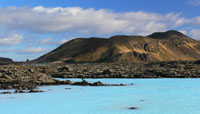
The tourism industry is highly developed in Iceland with coordination between transportation, the airports and hotels, as they are all owned by the airline. Flights to Iceland are only four hours from Boston and the continuation to Europe is between 2-3 hours, depending on your destination. They allow unlimited stopover to enjoy the country and therefore it makes it a great side trip off a visit to Europe.
The country population is small and therefore it is sparsely populated with the cities being very small. Reykjavik, by far the largest city is the size of a town like Ann Arbor or Madison. Therefore getting lost is not often a problem.
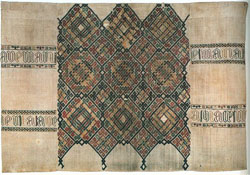 Icelandic Textiles
Icelandic Textiles
Immigrants from Scandinavia populated Iceland and therefore its handcrafts have close ties to its relatives in Norway, Sweden and Denmark. Knitting, Pattern Darning and Goldwork all are prevalent in the folk handcrafts of Iceland.
Places to visit
You must visit the National Museum of Iceland as it has the best overview of culture, handwork and history. Organized by time period, there are several important embroidered textiles on display. The museum shop has many of the books and leaflets I mention below.
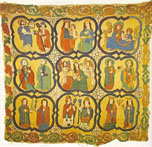
pjodminjasafn Islands
National Museum of Iceland
Sudurgata 41
101 Reykjavik
Phone: +354 530 2200
www.natmus.is
Icelandic Handcrafts Association (Reykjavik)
Every time I visit Iceland, I meet new people and learn more about this fascinating place. On my last trip, I visited the Iceland Handicrafts Association (heimilisionadarfelag Islands) and learned that there is a vibrant group who preserve the National Costumes from around 1800 onward. A limited number of extant costumes and photographs have been used to research the embroidery, clothing styles and fabrics. The community recreates the costumes, embroidery and jewelry as part of maintaining the cultural heritage.
There is a small shop (really a room) in the building. Called "Pjonustudeild" The Iceland Handicrafts Association is located at:
Pjonustudeild
Laufasvegur 2
101 Reykjavik
Phone: +354 551 5500
The building is nearly impossible to find as it is not marked but is a low white-sided building.
The entrance has a small set of doorbell plates (not in English). Look for the symbol or better yet, have called ahead so they know you will be coming at a particular time. The local number is: 551 5500. If you go, make sure to pick up some parchment and sifur vir (silver thread) and gull vir (gold thread) for working some of the traditional padded gold work on velvet.
Gullkistan (Reykjavik)
This is a shop on my list for my next trip. It is run by Dora Jonsdottir and is located in the center of Reykjavik near the intersection of Laugavegur and Frakkastigur streets:
Gullsmidur
Frakkastig 10
Phone: +354 551 3160
Email: gullkistan@vortex.is
Dora is silver smith and metal smith. They make belts, brooches, and other ornaments for national costumes. I have been collecting such jewelry from national costumes. As I have not visited, I am not sure if it is a shop or workshop by appointment. Email or call ahead to avoid embarrassment.
The Handknitting Association of Iceland
While I haven’t totally explored the knitting opportunities, the main gift store in the center of town sells both Icelandic sweaters (I am sure you will take these home) and local knitting yarns. A good site for learning more about Icelandic knitting is their website.
The Handknitting Association of Iceland
Skolavordustigur 19
101 Reykjavik, Iceland
Phone: +354 552 1890
handknit@handknit.is
www.handknit.is
Books to Buy in Iceland
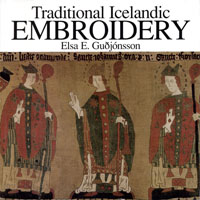 Traditional Icelandic Embroidery by Elsa E. Gudjonsson
Traditional Icelandic Embroidery by Elsa E. Gudjonsson
Before you go, try to read Elsa Gudjonsson's book "Traditional Icelandic Embroidery". It is in English and gives a wonderful overview of techniques and historic pieces that exist in collections in Iceland. Elsa was the former curator of Textiles and Costume in the National Museum of Iceland. Her book also includes 24 pages of patterns from historic textiles as well as some technique information.
While strong on medieval and early renaissance embroideries (especially church pieces) the book is weak on Icelandic National Costumes. Elsa followed up with a short pamphlet in English on National Costumes. The book is available on Amazon. Her pamphlet must be found in Iceland, but is relatively easy to find.
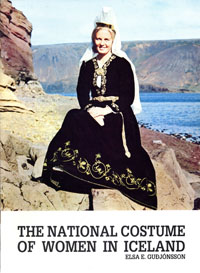 The National Costume of Women in Iceland by Elsa E. Gudjonsson
The National Costume of Women in Iceland by Elsa E. Gudjonsson
Elsa’s twelve-page pamphlet on the national costumes gives a good overview of the pieces of the ordinary dress and special occasion dress used by Icelandic women until around the turn of the century. Today, these examples are used to derive costumes used by Icelanders for some special occasions and folk dancing. Unlike other Scandinavian countries were great regionalism developed, the costume of Iceland doesn’t differ from one part of the country to another.
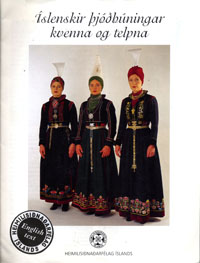 Islenskir Pjodbuningar Kvenna og Telpna by Heimilisidnadarfelag Islands
Islenskir Pjodbuningar Kvenna og Telpna by Heimilisidnadarfelag Islands
This small 20-page guide on modern Icelandic costumes is written both in Icelandic and English by the Icelandic Handcrafts Association (Heimilisidnadarfelag Islands). It is rich with photographs of Women’s, Men’s and children’s costumes. Included are descriptions of the lace, embroidery and silver jewelry used.
One of the parts of the costume embroidery that I enjoyed the most was the gold embroidered velvet. The designs are padded with cut parchment, a thick skin that is almost like cardboard. The gold to couched over the parchment figure, being held down at the sides and in any slits in the parchment (such as the vein of a leaf). The effect is a padded satin stitch, although the gold or silver thread doesn’t go through the velvet. This technique can also be used with silk with wonderful effect!
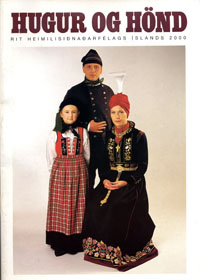 Hugur og Hond
Hugur og Hond
The Icelandic Handcrafts Association publishes this magazine and back issues are available in their one-room store. While written exclusively in Icelandic, it is filled with articles on both modern and historic handcrafts of all types. Ask to see some issues and you might see something you like.
|